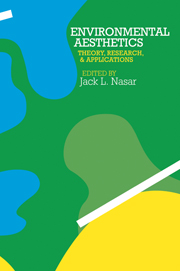Book contents
- Frontmatter
- Contents
- List of figures
- List of tables
- List of contributors and participants
- Acknowledgments
- Preface
- Section I Theory
- Editor's introduction
- 1 Behavioral and perceptual aspects of the aesthetics of urban environments
- 2 Symbolic aesthetics in architecture: toward a research agenda
- 3 Prospects and refuges revisited
- 4 Perception and landscape: conceptions and misconceptions
- 5 Where cognition and affect meet: a theoretical analysis of preference
- 6 The landscape of social symbols
- 7 Open space in cities: in search of a new aesthetic
- 8 Aesthetic perception in environmental design
- Section II Empirical studies
- Section III Applications
- References
- Index of authors
- Subject index
8 - Aesthetic perception in environmental design
Published online by Cambridge University Press: 05 September 2013
- Frontmatter
- Contents
- List of figures
- List of tables
- List of contributors and participants
- Acknowledgments
- Preface
- Section I Theory
- Editor's introduction
- 1 Behavioral and perceptual aspects of the aesthetics of urban environments
- 2 Symbolic aesthetics in architecture: toward a research agenda
- 3 Prospects and refuges revisited
- 4 Perception and landscape: conceptions and misconceptions
- 5 Where cognition and affect meet: a theoretical analysis of preference
- 6 The landscape of social symbols
- 7 Open space in cities: in search of a new aesthetic
- 8 Aesthetic perception in environmental design
- Section II Empirical studies
- Section III Applications
- References
- Index of authors
- Subject index
Summary
For well over two centuries, the doctrine of the disinterestedness of aesthetic perception has stood as a dogma of Western philosophy. Developing in the eighteenth century in the works of Shaftesbury and succeeding British writers, emerging as the theoretical centerpiece in Kant, elaborated by Schopenhauer, and refined by Bullough, Bergson, and Croce, aesthetic disinterestedness stands as a “major watershed in the history of aesthetics” (Stolnitz, 1961, p. 139). Indeed, up to the present time, the tendency to affirm this attitude has dominated most theoretical discussion in the English-speaking world.
Let me recall the claims of this idea by citing Kant's (1790) classic formulation:
Taste in the beautiful is alone a disinterested and free satisfaction; for no interest, either of sense or of reason, here forces our assent. . . . Taste is the faculty of judging of an object or a method of representing it by an entirely disinterested satisfaction or dissatisfaction. The object of such satisfaction is called beautiful.
(First Moment, 35).Although there is much in the Kantian aesthetic that continues to reflect our experience and claim our assent, such as his contention that the judgment of taste concerns pleasure that is unintellectual and immediate, there are facets of his view that reflect a tradition in aesthetics that is open to serious question. This is because the doctrine of disinterestedness and the correlative ideas that it fosters do not derive from a close examination of the conditions and features of our aesthetic experience of art and nature.
- Type
- Chapter
- Information
- Environmental AestheticsTheory, Research, and Application, pp. 84 - 98Publisher: Cambridge University PressPrint publication year: 1988
- 8
- Cited by



